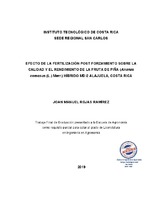Efecto de la fertilización post forzamiento sobre la calidad y el rendimiento de la fruta de piña (Ananas comosus (L.) Merr.) híbrido md-2 Alajuela, Costa Rica
Abstract
The purpose of this research was to evaluate the yield and quality in pineapple var. Ananas comosus (L.) Merr.) MD-2 hybrid, by foliar applications of increasing doses of potassium, calcium and boron in post-forcing stage in Alajuela, Costa Rica. This study was carried out at the Tres Amigos Agroindustrial Estate, located in Pital de San Carlos, beginning in July 2018 with the floral induction and ending in November 2018 at the time of harvest. The treatments were established as a percentage according to the dose, T1 was the 100% program where 200 Kg / ha of KCl, 200 Kg / ha of Ca (NO3)2 and 20 Kg / ha of boric acid were applied, subsequently the other programs were established at 75%, 50% and 25% of the dose of the previous doses, these applications were made at 30, 60,115 and 125 days after forcing that was done 132 days after planting, In addition, a relative control was taken into account corresponding to the normal applications of the farm which were applied only at 22 and 30 days after the forcing and finally an absolute control in which only water was applied. Internal variables such as acidity, brix degrees, and firmness of the pulp were measured, while the external variables were weight, height and diameter of fruit, weight and height of the crown and yield in boxes per hectare. It was determined that T100% is the treatment that managed to reach the highest acidity at harvest, t farm reported the highest SST equally to the harvest. According to the ° brix / acidity ratio, it is determined that all treatments met the desirable characteristics of a fruit for processing, it was also observed that T50% have positive effects, with significant differences in terms of performance variables, in addition to demonstrate that it generates greater partial utility.
Description
Tesis (Licenciatura en Ingeniería en Agronomía). Instituto Tecnológico de Costa Rica, Escuela de Agronomía, 2019.


